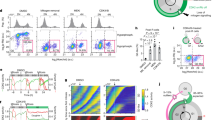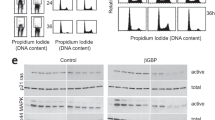Abstract
SEVERAL lines of evidence implicate the E2F transcription factor as an important component of cell proliferation control. First, E2F binding sites are found in the promoters of genes responsive to proliferation signals and the level of E2F binding activity increases at a time when many of these genes are activated1–3. Second, the tumour suppressor protein Rb, as well as the related p107 protein, complexes with E2F2–7, resulting in an inhibition of E2F transcriptional activity3,8–12. Third, oncogenic products of the DNA tumour viruses can dissociate these E2F complexes4,13. We provide here direct evidence that E2F is involved in cellular proliferation control. Specifically, we demonstrate that overexpression of the E2F1 complementary DNA14,15 can activate DNA synthesis in cells that would otherwise growth-arrest, with an efficiency that is similar to that achieved by the expression of the adenovirus El A gene. Moreover, microinjection of the E2F1 cDNA into quiescent cells can induce S-phase entry, whereas two E2F1 mutants, which are unable to transactivate the DHFR and TK promoters, are unable to induce S phase. We conclude that the E2F transcription factor plays an important role in progression into S phase and that this probably coincides with its capacity to stimulate transcription.
This is a preview of subscription content, access via your institution
Access options
Subscribe to this journal
Receive 51 print issues and online access
$199.00 per year
only $3.90 per issue
Buy this article
- Purchase on Springer Link
- Instant access to full article PDF
Prices may be subject to local taxes which are calculated during checkout
Similar content being viewed by others
References
Nevins, J. R. Science 258, 424–429 (1992).
Mudryj, M. et al. Cell 65, 1243–1253 (1991).
Schwarz, J. K. et al. EMBO J. 12, 1013–1020 (1993).
Chellappan, S. P., Hiebert, S., Mudryj, M., Horowitz, J. M. & Nevins, J. R. Cell 65, 1053–1061 (1991).
Bagchi, S., Weinmann, R. & Raychaudhuri, P. Cell 54, 1063–1072 (1991).
Chittenden, T., Livingston, D. M. & Kaelin, W. G. Cell 65, 1073–1082 (1991).
Bandara, L. R. & LaThangue, N. B. Nature 351, 494–497 (1991).
Hiebert, S. W., Chellappan, S. P., Horowitz, J. M. & Nevins, J. R. Genes Dev. 6, 177–185 (1992).
Zamanian, M. & LaThangue, N. B. EMBO J. 11, 2603–2610 (1992).
Weintraub, S. J., Prater, C. A. & Dean, D. C. Nature 358, 259–261 (1992).
Hamel, P. A., Gill, R. M., Phillips, R. A. & Gallie, B. L. Molec. cell. Biol. 12, 3431–3438 (1992).
Dalton, S. EMBO J. 11, 1797–1804 (1992).
Challappan, S. P. et al. Proc. natn. Acad. Sci. U.S.A. 89, 4549–4553 (1992).
Helin, K. et al. Cell 70, 337–350 (1992).
Kaelin, W. G. et al. Cell 70, 351–364 (1992).
Stabel, S., Argos, P. & Philipson, L. EMBO J. 4, 2329–2336 (1985).
Lillie, J. W., Loewenstein, P. M., Green, M. R. & Green, M. Cell 50, 1091–1100 (1987).
Moran, B. & Zerler, B. Molec. cell. Biol. 8, 1756–1764 (1988).
Howe, J. A., Mymryk, J. S., Egan, C., Branton, P. E. & Bayley, S. T. Proc. natn. Acad. Sci. U.S.A. 87, 5883–5887 (1990).
Kaczmarek, L., Ferguson, B., Rosenberg, M. & Baserga, R. Virology 152, 1–10 (1986).
Spindler, K. R., Eng, C. Y. & Berk, A. J. J. Virol. 53, 742–750 (1985).
Lipson, K. E. & Baserga, R. Proc. natn. Acad. Sci. U.S.A. 86, 9774–9777 (1989).
Roehl, H. H. & Conrad, S. E. Molec. cell. Biol. 10, 3834–3837 (1990).
Means, A. L., Slansky, J. E., McMahon, S. L., Knuth, M. W. & Farnham, P. J. Molec. cell. Biol. 12, 1054–1063 (1992).
Blake, M. C. & Azizkhan, J. C. Molec. cell. Biol. 9, 4994–5002 (1989).
Goodrich, D. W., Wang, N. P., Qian, Y. -W., Lee, E. Y. -H. P. & Lee, W. -H. Cell 67, 293–302 (1991).
Qin, X. -Q., Chittenden, T., Livingston, D. M. & Kaelin, W. G. Jr Genes Dev. 6, 953–964 (1992).
Qian, Y., Luckey, C., Horton, L., Esser, M. & Templeton, D. J. Molec. cell. Biol. 12, 5363–5372 (1992).
Slansky, J. E., Li, Y., Kaelin, W. G. & Farnham, P. J. Molec. cell. Biol. 13, 1610–1618 (1993).
Shirodkar, S. et al. Cell 68, 157–166 (1992).
Cross, W. D., Johnson, D. J. & Nevins, J. R. Molec. cell. Biol. (in the press).
Author information
Authors and Affiliations
Rights and permissions
About this article
Cite this article
Johnson, D., Schwarz, J., Cress, W. et al. Expression of transcription factor E2F1 induces quiescent cells to enter S phase. Nature 365, 349–352 (1993). https://doi.org/10.1038/365349a0
Received:
Accepted:
Issue Date:
DOI: https://doi.org/10.1038/365349a0
This article is cited by
-
Retinoblastoma: present scenario and future challenges
Cell Communication and Signaling (2023)
-
Positive regulation of ataxia-telangiectasia-mutated protein (ATM) by E2F transcription Factor 1 (E2F-1) in cisplatin-resistant nasopharyngeal carcinoma cells
World Journal of Surgical Oncology (2022)
-
Differential regulation of mammalian and avian ATOH1 by E2F1 and its implication for hair cell regeneration in the inner ear
Scientific Reports (2021)
-
Modulation of TCR signalling components occurs prior to positive selection and lineage commitment in iNKT cells
Scientific Reports (2021)
-
Molecular Mechanisms for Krüppel-Like Factor 13 Actions in Hippocampal Neurons
Molecular Neurobiology (2020)
Comments
By submitting a comment you agree to abide by our Terms and Community Guidelines. If you find something abusive or that does not comply with our terms or guidelines please flag it as inappropriate.



